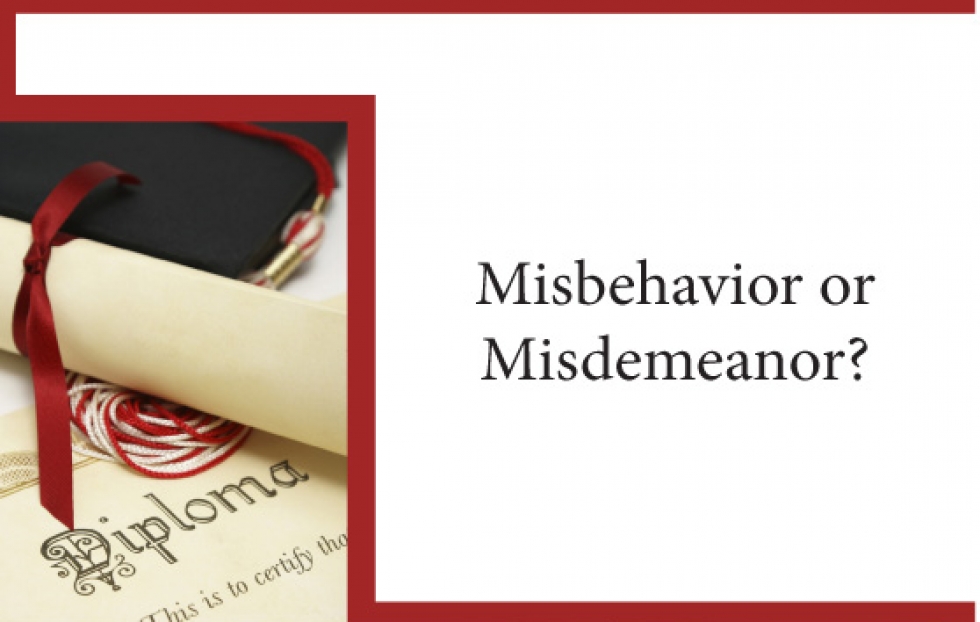School disciplinary actions are decreasing in Utah’s public school system, but disparities in the amount of discipline administered along racial lines continues to exist and in some cases has worsened, according to a new joint report released today by the University of Utah S.J. Quinney College of Law and Voices for Utah Children, a non-profit in Salt Lake City focused on children’s issues.
The report, Misbehavior or Misdemeanor? A Report on the Utah’s School to Prison Pipeline, builds on two earlier reports produced by the S.J. Quinney College of Law Public Policy Clinic focused on the current state of Utah’s school-to-prison pipeline. In October 2014, the clinic released “From Fingerpaint to Fingerprints: The School to Prison Pipeline in Utah” and in May 2015, the clinic released “Disparities in Discipline: A Look at School Disciplinary Actions for Utah’s American Indian Students”.
In the newest report, researcher Vanessa Walsh, a 2016 S.J. Quinney College of Law graduate now employed with Salt Lake County’s Criminal Justice Advisory Council, teamed up with Lincoln Nehring, director of the S.J. Quinney College of Law’s Public Policy Clinic and CEO of Voices for Utah Children, to explore how trends have shifted in school discipline since the publication of the earlier reports.
The duo found that while Utah saw nearly a 30 percent reduction in school disciplinary actions from the 2011-12 school year to the 2013-14 school year (the most recent data available), discipline rates of students who are racial minorities are still elevated in comparison to white peers. “The worsening disparity among racial lines remains troubling,” said Nehring.
The newest report also found:
● In the 2013-2014 school year, almost 9 percent of black students, 8.5 percent of American Indian students, and approximately 5 percent of Pacific Islander and Hispanic students received a suspension. In comparison, only slightly more than 2 percent of white students were suspended.
● In the 2011–12 school year, Hispanic students were 1.3 times more likely than white students to be expelled. This increased to 2.3 times more likely in 2013–14. Asian students were less likely than white students to be expelled in 2011, but they were 3.3 times more likely to be expelled in the 2013-14.
● During the 2013–14 school year, 1.5 percent of American Indian students and almost 1.2 percent of black students were referred to law enforcement. In comparison, less than one half of one percent (0.4 percent) of white students received this action
● American Indian students were 6.2 times more likely than white classmates to be arrested at school in the 2011–12 school year. That disparity increased to 8.8 times more likely in the 2013–14 school year. Similarly, students who identified as Pacific Islander were 1.7 times more likely to be arrested at school in 2011–12 and 3.3 times more likely in 2013–14.
● American Indian student feel the brunt of school disciplinary actions in every category except in-school suspensions, researchers found. Overall,10.3 percent of all American Indian students received some sort of school disciplinary action in the 2013–14 school year. In comparison, 5.6 percent of all other students of color received an action, and 2.6 percent of the white student population received an action.
“Fewer students are being exposed to the juvenile justice system as a result of referrals to law enforcement while at school and school related arrests but as was the case in 2011-12, our American Indian students continue to disproportionately receive these actions,” said Walsh. “These actions directly expose students to the justice system and can leave these students with a juvenile record.”
The researchers will continue to track school discipline rates as part of their ongoing efforts to study the school-to-prison pipeline.
View full report: ![]() Misbehavior or Misdemeanor? A Report on the Utah’s School to Prison Pipeline
Misbehavior or Misdemeanor? A Report on the Utah’s School to Prison Pipeline
For 30 years now, Voices for Utah Children has called on our state, federal and local leaders to put children’s needs first. But the work is not done. The children of 30 years ago now have children of their own. Too many of these children are growing up in poverty, without access to healthcare or quality educational opportunities.
How can you be involved?
Make a tax-deductible donation to Voices for Utah Children—or join our Network with a monthly donation of $20 or more. Network membership includes complimentary admission to Network events with food, socializing, and opportunity to meet child advocacy experts. And don't forget to join our listserv to stay informed!
We look forward to the future of Voices for Utah Children and we hope you will be a part of our next 30 years.
Special thanks to American Express, our "Making a Difference All Year Long" sponsor. 






